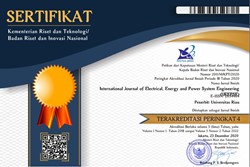Characteristic Tests of Bio-pellets Made of Calliandra Wood as a Renewable Alternative Fuel
Abstract
Calliandra wood is a kind of forest biomass located in Baturaden Adventure Forest (BAF). The availability of which is quite abundant, so it has such an outsized potential to be processed into biopellets. This study was aimed at creating biopellets made of Calliandra wood and assessing their calorific value and their proximate value, and doing the mechanical and the combustion tests. This wood was converted into bio-pellets by employing several processes such as the drying, crushing, and milling processes, as well as the process of a 60-mesh sifting and the process of printing the bio-pellets with a starch adhesive of 16% Calliandra wood powder mass. Based on the results of this study, it was found out that the characteristics of the Calliandra wood biopellets taken from BAF had met the standards recommended by SNI 8021:2014, namely that of an over 4000 cal/gr calorific value, 3.6 % maximum moisture content, 69.4% maximum volatile matter content, 0.95% maximum ash content and 26% minimum fixed carbon content. The tests found out that the maximum stress value was 2.5MPa. and 66gram Calliandra wood bio-pellet could boil 500 ml of water in 6.5 minutes. Therefore, the biopellets can highly effectively be used as an alternative fuel.
References
R. Effendi, N. Roffandi, T. Puspitodjati, and I. Bangsawan, “Menggagas energi biomassa hutan sebagai sumber energi terbarukan,” Penelit. dan Pengemb. Sos. Ekon. Kebijak. Dan Perubahan Iklim, vol. 11, no. 02, pp. 1–5, 2018.
A. Bunyamin and D. Purnomo, “Potential impact of beekeeping activity on bioenergy supply in West Java, Indonesia,” IOP Conf. Ser. Earth Environ. Sci., vol. 460 012023, no. 1, pp. 1–5, Mar. 2020.
S. Mustamu, D. Hermawan, and G. Pari, “Karakteristik Biopelet Dari Limbah Padat Kayu Putih Dan Gondorukem,” J. Penelit. Has. Hutan, vol. 36, no. 3, pp. 191–204, 2018.
Maemuna, M. Jaya, and M. N. A. Sofyan, “Pemanfaatan Biomassa Tumbuhan Menjadi Biopellet sebagai Alternatif Energi Terbarukan,” Hasanuddin Student J., vol. 2, no. 1, pp. 180–188, 2018.
S. Sylviani and E. Yosefi Suryandari, “Potensi Pengembangan Industri Pelet Kayu Ssbagai Bahan Bakar Terbarukan Studi Kasus Di Kabupaten Wonosobo,” J. Penelit. Sos. dan Ekon. Kehutan., vol. 10, no. 4, pp. 235–246, Dec. 2013.
I. Pradnyaswari, J. N. Pongrekun, P. Ridhana, and I. Budiman, “Barriers and Opportunities of Bio pellets Fuel Development in Indonesia: Market Demand and Policy,” IOP Conf. Ser. Earth Environ. Sci., vol. 997 012003, no. 1, pp. 1–15, Feb. 2022.
SNI 8021:2014 BSN, “SNI Pelet Kayu,” 2014.
C. P. Artemio, N. H. Maginot, C.-U. Serafín, F. P. Rahim, R. Q. José Guadalupe, and C.-M. Fermín, “Physical, mechanical and energy characterization of wood pellets obtained from three common tropical species,” PeerJ, vol. 6, Sep. 2018.
P. Science, N. Resources, and L. Banos, “Physico – Chemical Properties Of Wood Pellets From Forest Residues,” vol. 26, no. 4, pp. 589–595, 2014.
R. J. Silmi Yusri Rahmadani, Alponsin Alponsina,Tesri Maidelizaa, “Karakteristik Anatomi Dan Energi Kayu Dari Tiga Tumbuhan Invasif,” J. Ris. Ind. Has. Hutan, vol. 13, no. 1, pp. 1–14, 2021.
N. Hendrati,R.L dan Hidayati, Budidaya Kaliandra (Calliandra calothyrsus) Untuk Bahan Baku Sumber Energi, Cetakan Pe. PT Penerbit IPB Press, 2014.
E. Prasetyo et al., “Penanaman Kaliandra Sebagai Kayu Energi dan Hijauan Makanan Ternak Pada Pertanaman Agroforestri Masyarakat Desa Gerbosari, Samigaluh Kulon Progo,” J. Pengabdi. dan Pengemb. Masy., vol. 1, no. 1, pp. 1–10, May 2018.
M. A. Susi Rahayu, Sitti Hilyana, Embun Suryani, Nazmi Herlina Sari, “Analysis of Wood Pellet Quality from Calliandra Callothyrsus, Gliricida Sepium, and Sawdust as New and Renewable Energy,” in Proceedings International Conference on Science and Technology (ICST), pp. 110-115, 2020.
S. Y. Adaganti, V. S. Yaliwal, B. M. Kulkarni, G. P. Desai, and N. R. Banapurmath, “Factors Affecting Bioethanol Production from Lignocellulosic Biomass (Calliandra calothyrsus),” Waste and Biomass Valorization, vol. 5, no. 6, pp. 963–971, Dec. 2014.
R. Lies Indrayanti, Alpian Wahyu Supriyati, Renhart Jemi,Theresia Anggreini Sirait, “Kualitas Pelet Tiga Jenis Kayu: Bangkirai (Shorea laevis Rdl), Sungkai (Peronema canescens Jack) Dan Meranti Merah (Shorea leprosula Mig),” Agrenvi, vol. 14, no. 1, pp. 13–23, 2014.
K. N. M. Faisal Mahdie, Noor Mirad Sari, “Sifat-sifat penyalaan dari pembakaran biopellet dari limbah serbuk kayu ulin dan limbah serbuk kayu campuran (balsa dan meranti) sebagai energi terbarukan,” Pros. Semin. Nas. Lingkung. …, vol. 3, no. April, pp. 429–432, 2018.
E. Arsad, “Sifat Fisik Dan Kimia Wood PelletT Dari Limbah Industri Perkayuan Sebagai Sumber Energi Alternatif (Carakteristic Physical and Chemistry of Wood pellet from Industrial Disposal of Wood as Sources Energy Alternatif),” J. Ris. Ind. Has. Hutan, vol. 6, no. 1, pp. 1–8, 2014.
W. J. Cichy, A. Panek, and D. Radoński, “Assessment of mechanical properties of pellets made from wood raw materials,” vol. 9, pp. 35–39, 2014.
Copyright (c) 2022 Rosyida Permatasari, Muthia Atikayanti, Elisanti Sugitha Ginting

This work is licensed under a Creative Commons Attribution-NonCommercial 4.0 International License.


















